This Post May Contain Affiliate Links
In compliance with the FTC guidelines, please assume that some of the links on these posts and sites are affiliate links (Amazon or others) from which I may earn a small compensation/commission from sales of certain items at no extra cost to you from qualifying purchases.
Anytime you see a link that looks like “astore.com, paid link, #ad, #CommissionsEarned or Amazon/Amazon.com/ca,”… it can be assumed that it is an affiliate link.
To learn more, follow the link below.
Guitar Neck Construction
3 Main Neck Joint Types
Guitar neck construction refers to how the guitar body and necks are joined together.
So why is it important?
How joints are manufactured plays a part in the overall sound transmission between the neck and body, along with tone, playability, sustain, and resonance.
All have advantages and disadvantages, along with player preferences and beliefs.
With all of the different guitar builds, there are 3 main types of neck joints.
- Bolt-on – Necks attached to the guitar body with screws and often a metal plate.
- Set-neck – Necks that are glued to the guitar body.
- Neck-Thru – Necks that run through the entirety of the guitar’s body as one piece.
If you’re in the market for a new guitar, you’ve probably heard the terms, but what do they mean?
History Of Bolt-on Neck Type
In 1949, Leo Fender began experimenting with new guitar designs, creating a prototype single coil pickup guitar called the Fender Esquire with an Ash body and Maple bolt-on neck.
Being the first solid-body guitar sold by Fender, it debuted in 1950. (See image)
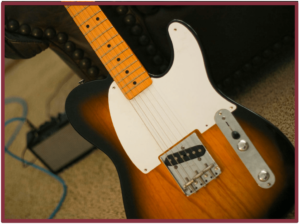
A One Pickup single-coil Esquire in two-tone sunburst with bolt-on neck construction. Image courtesy of Wikipedia- Author Manley. Josh – and is licensed under the CC BY 2.0
Challenged Ridden
The instrument had a one-piece laminated bolt-on maple neck that, due to the string tension and environmental factors and changes, bowed, forcing the company to replace almost all of the 50 guitars manufactured under warranty, resulting in this model being discontinued.
Introduction Of The Truss Rod
To solve this issue and meet the specific needs of the musician, Fender came up with an addition of the Metal Truss Rod into the necks allowing for much-needed tuning stability, with this design being incorporated to the present day.
Telecaster Is Born

A Fender Telecaster American Vintage 1952 with a Maple Bolt-on Neck construction and Truss rod-Image courtesy of Wikimedia -Author- Massimo Barbieri and is licensed under the CC BY-SA 3.0
The Fender Telecaster was the sister model to the Esquire except with 2 pickups and was initially introduced as the “Broadcaster“ (1950), then “Nocaster” (1951) and with the advent of Television, the final name of “Telecaster” was applied to the guitar.
The ‘Tele” was the world’s first mass-produced, commercially successful solid-body electric guitar. Its effective design set standards and trends in electric guitar manufacturing and has remained in continuous production, mostly unchanged from the 1950s.
This design can be used in any genre of music because of the bright attack output, and have been the instrument of choice for iconic players like Jeff Beck and Jimmy Page.
Along with adding the addition of a Truss Rod, Fender also went with a Bolt-on Neck Construction.
What is a Bolt-on Neck?
This joint has the neck and body manufactured separately, then attached together, and is by far the most common neck construction design in electric guitars and easiest to identify.
First Glance
Bolt-on constructions are usually very obvious. Normally, when you flip the guitar over, you’ll see a metal plate at the top of the body called a neck plate. This is used to cover and hold the screws in place, with some new variations coming later. (See Image)

Fender Player Stratocaster Electric Guitar – Maple Fingerboard – 3 Color Sunburst w/Bolt on Neck design – Image courtesy of Amazon
A bolt-on neck is anchored to the body wood with 4-5 screws, not bolts as the name suggests, on a series of ferrules allowing for easy cost-effective removal and replacement of the neck in the event of damage.
Cost Effective
This design is the easiest, quickest and most effective process of manufacturing a guitar for mass production, with the final assembly done quickly by production workers.
Fender has been doing this starting in the early ’50s to the present day, resulting in durable instrument designs that have incredible playability and are rich in tone.
Sound Type
Bright
Bolt-on necks, despite having a tightly fitted assembly at the junction point, usually do not provide as much resonance; the slight gap between the neck and body slows the sustain, creating a small barrier compared to other designs.
The results are a bright sharp twangy cutting tone with note definition.
The Bolt-On Neck And Heel Designs
Some bolt-on designs use a metal neck plate at a flat angle, while other similar designs contour the heel to make it more comfortable to play in the upper regions of the fretboard. (More on this later)
A heel is located where the neck and the body meet. (See Image)

Traditional Bolt-on Heel Design w/Neck plate and 4 screws — Image courtesy of Wikipedia – and is licensed under the CC BY-SA 2.5
A good, tight-fitting neck is essential to getting the best tone possible and is a component that supports the guitar’s design but is not as ergonomic as some of the newer concepts.
Heel Design Variation
Contoured Neck Heel
With the ease of access to the higher frets in other neck construction designs brought on by the SuperStrat, the bolt-on has had some design modifications made by contouring the traditional “heel” of the guitar. (See image)
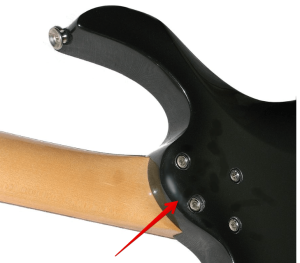
A Modern Contoured Heel for a Bolt-On Neck Construction on a Superstrat-Style Solid Body Electric Guitar- Image Courtesy of Wikimedia and is licensed under the CC BY-SA 3.0
Some manufacturers work with top players to create other varied bolt-on designs, like on the Nuno Bettencourt Washburn N4 and the Stephen’s Extended Cutaway.(See image)

Stephen’s Extended Cutaway (On the Nuno Bettencourt Signature)-Image courtesy of Wikipedia – Author ZeGlobox and has been released into the public domain
Also important to mention is that the Stephens Extended Cutaway success went on to inspire Washburn to go from a modified “bolt-on” to a “set-in” neck joint and cutaway for their future Parallaxe models to the present day.
Advantages
- Easily Removed, Repaired & Replaced – in the event the neck breaks, is damaged or becomes defective. Simply buy a new neck that matches the old one and swap the broken one out.
- Cost-Effective – Cheaper manufacturing process
- Easier Setup
- Customization – The ability to buy replacement and swap necks for different fretboards or wood types.
- Produces a Bright Snappier, Defined Tone
- Used by the Most Established Brands & Players
Disadvantage
- Lost Resonance & Sustain – Because of the junction point where the guitar neck and body connect; this will affect the instrument’s resonance & sustain with loss of tone quality, making the sound output appear thinner.
- Less Ergonomic – May feel uncomfortable with traditional blocky heel designs, affecting playability in the higher regions of the neck.
- Susceptible to Climate – Having a separate construction can mean having a neck that can be affected by environmental changes.
- Cosmetics -Compared to the other neck constructions, the bolt-on may not look as “clean.”
The “set neck” method has always been used in acoustic, semi-acoustic and classical guitars, but in the electric guitar marketplace, Gibson Guitar Corporation, PRS Guitars, and Gretsch are well known for applying this method in their high-end models; and are ambassadors for the neck design type.

An ESP LTD EC-256FM Electric Guitar, Cobalt Blue with Standard “set neck” gluing, image courtesy of Amazon
First Glance
The obvious sign that these are set neck joints is when you flip the guitar over; there is a lack of screws or metal plates. (There won’t be any) you simply see a cleaner design.
You’ll also notice that set-neck guitars typically use the same finish or paint on the body and the back of the neck.
Heel Designs
With a Set in Neck, there are more opportunities to shape and finish the neck joint differently.
Some set-neck guitars have smooth and ergonomic contours that give easy access to the upper frets, while others almost look like bolt-on necks. (See Image)

An ESP LTD EC-256FM Electric Guitar in Cobalt Blue with a Set In Neck design, w/no screws or neck plate, matching paint and a traditional Les Paul heel.
Production
More expensive to make than the “bolt-on,” the complexity of the construction lies largely in the perfection of the joint and in the angle of the neck/body slant, with correct adjustment of the bridge and string action.
Attention To Detail
The “set neck” method requires advanced craftsmanship for the attachment and a lot of care in the design and application,
As with the “neck-through,” in the event of a defective neck, a replacement can get problematic and costly.
Sound Type
Tonal transfer between the neck’s fretboard and body is generally better than in a traditional bolt-on because of the always precious contact between the body and the neck with the glued-on design.
The guitar maker uses certain tonewoods (like mahogany) to favour certain sounds.
This design gathers up all of the energy from your strings, with vibrations flowing and travelling freely, distributing out of the body of the guitar, producing a thicker, fuller, warmer sound, with a fatter body to the notes’ along with better resonance and sustain.
The iconic Les Paul is a common example of a set-neck sound type that can be used for anything from rock to metal. (See Image)
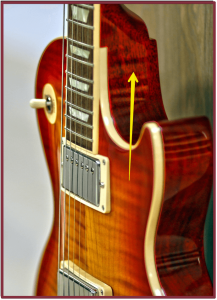
The Iconic Les Paul w/Set in Neck Construction & Heel
Advantages
- Improved Resonance & Sustain– With the overall combination of a stronger body-to-neck connection than a bolt-on design, along with advanced craftsmanship, many believe this also improves the resonance of the instrument.
- Improved Upper Fretboard Access & Comfort – Even with a heel left behind by a traditional Set in design, it still provides better access than the traditional Bolt-on versions.
- Cosmetically More Appealing.- One of the best things about the set-neck construction is that, cosmetically, it has a cleaner look and aesthetic.
- Warmer Fuller Sound – Vibrations distribute out of the body of the guitar, producing a thicker, fuller, warmer sound.
- sually found on mid-range and high-range guitars, the price tag for this type of neck construction is affordable.
Disadvantages
- Harder to Repair & Replace – With the set neck construction needing to have the glue loosened to be able to separate the body and neck, is very difficult to impossible to repair, replace or reset damaged necks, and should only be performed by an experienced luthier.
- Slower Production – Even though this design is affordable, with increased materials and craftsmanship, time production is slower, and consumer costs can be higher.
- Cannot Mix & Match Necks – You can’t change the neck on a set-neck guitar if you prefer the shape of another.
The last type of guitar neck joint is very different from bolt-on or set necks.
Neck-Thru
What Is A Neck-Thru Construction?
This is a name given to the type of manufacturing that produces the guitar neck and body together in one piece.
Set-through necks are relatively uncommon; only a handful of manufacturers produce such joints.
Neck-thru is when the same piece of wood that makes up the neck of a guitar also makes up the middle section of the body itself. The neck extends and continues through the entirety of the guitar’s body with a single piece of wood.
Using a laminate construction process, 2 pieces of wood are added to both sides of the neck (top and bottom of the body), making up “wings,” which become the bottom and top third of the guitar. This section then mounts the hardware (i.e. bridge, saddles and pickups.)
(See Image)

An Ibanez RG Premium Electric Guitar – Deep Twilight Flat Sporting a bridge & pickups on neck wood section with “wings” laminate together.- Image courtesy of Amazon.
History Of The Neck Thru
In 1956 Rickenbacker was one of the first guitar manufacturers to use this design,
First Glance
Unlike the bolt-on and set-neck constructions, you won’t see any separation between the neck and body of the guitar. (See Image)
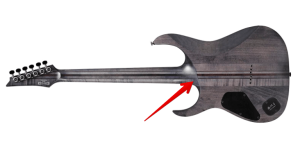
Image of the Ibanez RG Premium Electric Guitar – Deep Twilight Flat w/No neck joint – image courtesy of Amazon
Durable
The Neck-thru gives guitar makers more opportunity to laminate and bind different wood types together and offers incredible durability.
Because neck-thru guitars are often made of different types of wood (3-7 pieces), the neck will be less susceptible to conditions that might cause warp and twists. It’s almost like the woods counteract each other for more stability. (See Image)
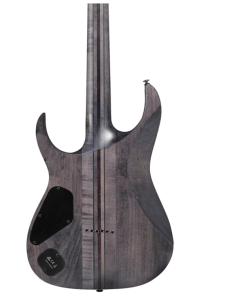
An Ibanez RG Premium Electric Guitar – Deep Twilight Flat with a laminated 5-wood neck-thru construction for durability – Image courtesy of Amazon
Production
The neck-thru design is usually only ever used on a brand’s premium/higher-end guitars, as they are typically a lot more complicated to make and much more expensive.
It takes a lot of work and precision for a luthier to make a guitar with this construction; production is slower and more costly.
Risk
One of the biggest risks of owning a neck-through-body guitar is the possibility of irreversible damage.
Extreme FretBoard Freedom
With This neck-thru design, luthiers can shape and contour the neck in ways that are impossible with bolt-on or set neck constructions, creating extreme freedom in the upper range of the fretboard; for there is no heel at the neck joint.
Neck-thru guitars tend to transition from neck to body smoothly, making it extremely enjoyable to play on the higher Fretboard regions. (See image)
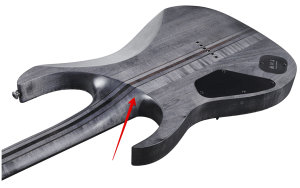
The Ibanez RG Premium Electric Guitar – Deep Twilight Flat w/contoured Neck-Thru Construction for extreme playability-Image courtesy of Amazon
Sound Type
The Neck-thru constructions generally offer better Tonal quality, resonance and sustain than the previous designs because there is no junction point or separation between the neck and the body, with the string vibration perfectly travelling the length of the entire guitar.
The strings will vibrate the entire piece of wood that is housing the pickups and transfer sound to your amp.
A Gibson Firebird is a famous example, with the pickups mounted on the piece of wood that runs through the body. Neck-through has also been hailed as one of the best when it comes to sustainability.
Advantages
- Top Quality Tone Resonance & Sustain – With no separation between neck and body, tone resonance and sustain are optimized.
- Fretboard Freedom -Offers the best upper fret access, ease of play and comfort out of all neck joint types
- Increased Strength – with better tuning stability.
- Cosmetics – The construction design has a look that is super slick and clean.
Disadvantages
- Impossible To Replace – Depending on the damage, you may need to purchase an entirely new guitar.
- More Difficult & Expensive To Build -Due to the complexity, a lot of skilled labour and time is needed, which increases manufacturing costs.
- Cannot Mix & Match Wood – This design limits your opportunity for customization
Do Neck Thru Necks Still, Need Truss Rods?
At the end of the day, this post is a guideline for the different guitar neck constructions, but it’s most important to let your hands and ears make the decisions, for every guitarist has different preferences.
Even though different neck designs contribute to the overall tone and playability of the instrument, choose one that is right for you and your musical style.
Try out a lot of different guitars and see what feels right within your price margins.
Compare models that are of similar build quality and specifications.
Consider the entire guitar as a whole.
It’s also worth having different guitars in your arsenal to get those different sounds.
Other Factors
There are other factors to consider, like craftsmanship and the quality of the build (i.e. type of bridge, tuners, pickups, etc.) individually and collectively combined; the neck joint will play less of a role than most people think.
You will find high-quality, great-sounding guitars of all varieties, whether bolt-on, set-neck or neck-thru.
Did You Like This Article?
Check out my post on if you need a Guitar String Dampener
Leave your comments in the section below if you would like me to review a favourite guitar or player.
As always, stay the course and keep playing.
Feature Image of 3 Neck Constructions courtesy of Amazon
Image of Les Paul Courteys of Moerschy from Pixabay
Final thoughts image courtesy of bing.com

Starting A Journey At 7 Years Of Age, The Love For The Guitar Only Became Stronger Going Into My Teens. This Leading To An Exciting Time Of Teaching, Performing, And Recording. Join Me Now As We Can Bring The Love Of This Instrument To Other Musicians Globally.

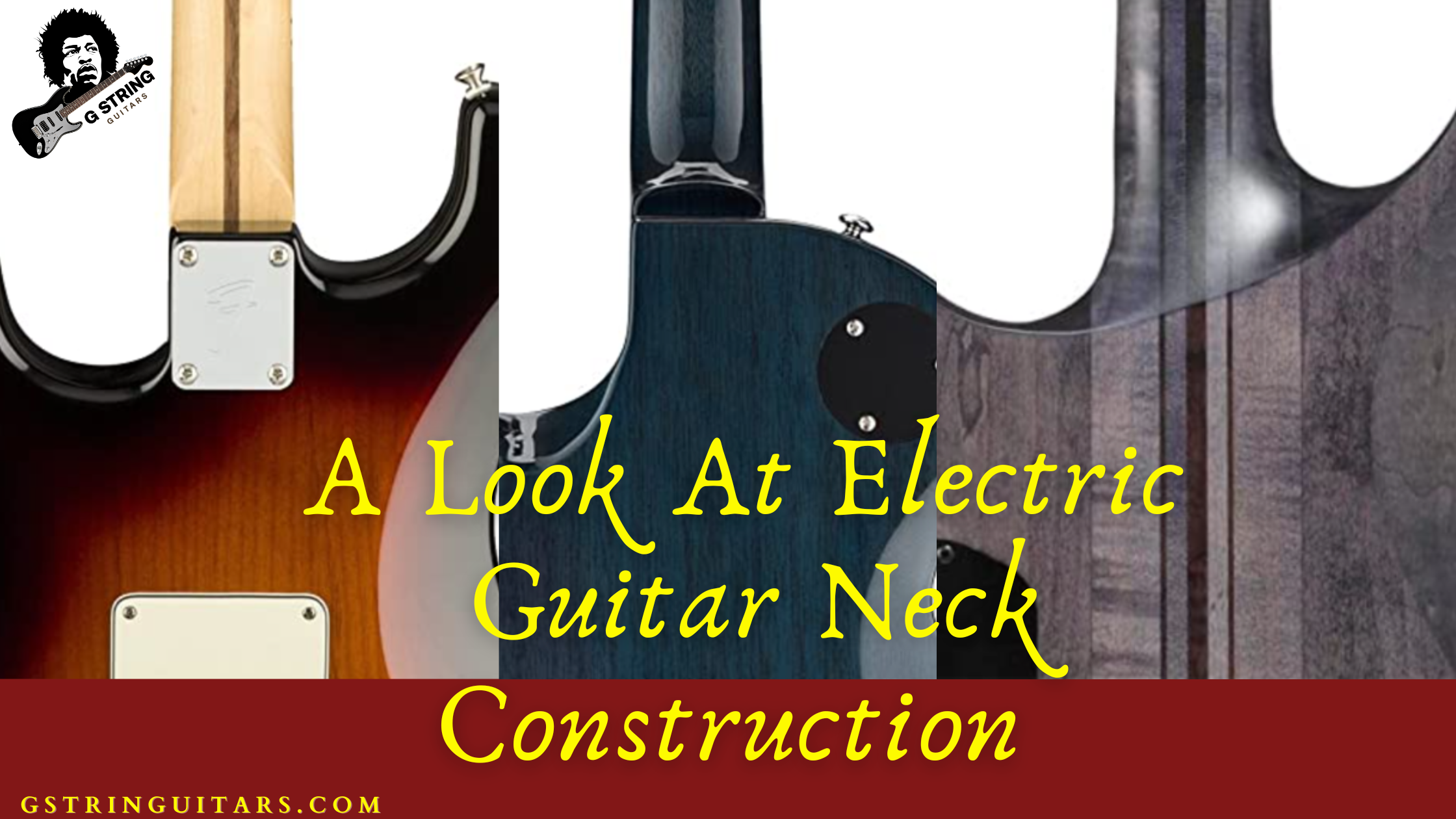






Wow, this article reads like a love letter to guitars! Musical instruments, especially guitars, have always fascinated me. Though I’ve spent more time with djembes. Guitars have both, intimidated me and fascinated me! I’ve recently been learning to strum a bit, mostly through Youtube, on an old rusty guitar! But I’ve been meaning to purchase a new one. What do you personally recommend – bolt-ons or set-necks?
Hello Sanaa
Great to meet you, and thank you for visiting the site and leaving your feedback.
Guitars are funny instruments for they become a thing of passion, and since there is so much going on in the guitar world, it is easy to focus on a section of the industry that you love and write a ton of value-based information.
Since you are starting, more than likely, if you are getting an electric guitar, it will be a bolt-on simply based on price, but if it is an acoustic, a set in will be expected.
The best thing about the guitar is pick it up and ‘”Play.” A lot of the intimidation will turn into curiosity to continue.
But there are so many other benefits to learning this amazing instrument; check out our post on “My life lessons learned from playing the guitar.”
Good luck in your journey, and do not hesitate to return and leave your thoughts.
GSG